Related Research Articles
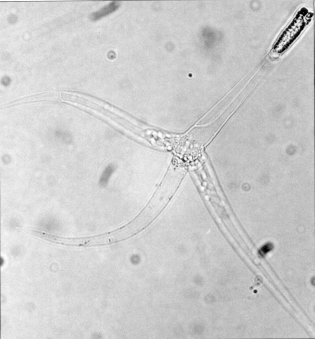
Myxozoa is a subphylum of aquatic cnidarian animals – all obligate parasites. It contains the smallest animals ever known to have lived. Over 2,180 species have been described and some estimates have suggested at least 30,000 undiscovered species. Many have a two-host lifecycle, involving a fish and an annelid worm or a bryozoan. The average size of a myxosporean spore usually ranges from 10 μm to 20 μm, whereas that of a malacosporean spore can be up to 2 mm. Myxozoans can live in both freshwater and marine habitats.

Ichthyophthirius multifiliis, often termed "Ich", is a parasitic ciliate described by the French parasitologist Fouquet in 1876. Only one species is found in the genus which also gave name to the family. The name literally translates as "the fish louse with many children". The parasite can infect most freshwater fish species and, in contrast to many other parasites, shows low host specificity. It penetrates gill epithelia, skin and fins of the fish host and resides as a feeding stage inside the epidermis. It is visible as a white spot on the surface of the fish but, due to its internal microhabitat, it is a true endoparasite and not an ectoparasite.
Perkinsus marinus is a species of alveolate belonging to the phylum Perkinsozoa. It is similar to a dinoflagellate. It is known as a prevalent pathogen of oysters, causing massive mortality in oyster populations. The disease it causes is known as dermo or perkinsosis, and is characterized by the degradation of oyster tissues. The genome of this species has been sequenced.
Perkinsus is a genus of alveolates in the phylum Perkinsozoa. The genus was erected in 1978 to better treat its type species, Perkinsus marinus, known formerly as Dermocystidium marinum. These are parasitic protozoans that infect molluscs, at least some of which cause disease and mass mortality. P. marinus is the most notorious, causing the disease perkinsosis, or dermo, in wild and farmed oysters.

Myxobolidae is a family of myxosporean parasites which typically infect freshwater fishes, and includes the economically significant species, Myxobolus cerebralis. They have been shown to have a complex life cycle, involving an alternate stage in an invertebrate, typically an annelid or polychaete worm.

The Ichthyosporea are a small group of Opisthokonta in Eukaryota, mostly parasites of fish and other animals.
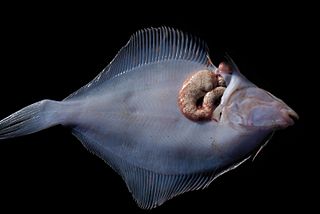
A xenoma is a growth caused by various protists and fungi, most notably microsporidia. It can occur on numerous organisms; however is predominantly found on fish.
Psorospermium haeckeli is a parasitic species.
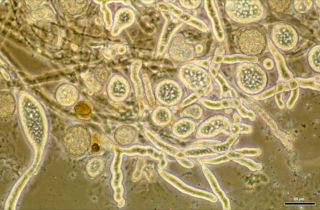
Ichthyophonus is a genus of unicellular eukaryotic parasites of fish. They were once considered to be fungi, but phylogenetic evidence suggests they are protists related to both fungi and animals.
Sphaerothecum destruens is a parasite of fish. It was first discovered in the United States in association with invasive species including topmouth gudgeon, but was found to be the causative agent of a disease in the UK affecting salmonid species such as Atlantic salmon and brown trout. It is thought to pose more of a risk in Europe than in the US, as native species there are more susceptible to the parasite. The disease causes high rates of morbidity and mortality in a number of different salmonid species and can also infect other UK freshwater fish such as bream, carp, and roach. The genus Sphaerothecum is closely related to the genera Dermocystidium and Rhinosporidium.

Holozoa is a clade of organisms that includes animals and their closest single-celled relatives, but excludes fungi and all other organisms. Together they amount to more than 1.5 million species of purely heterotrophic organisms, including around 300 unicellular species. It consists of various subgroups, namely Metazoa and the protists Choanoflagellata, Filasterea, Pluriformea and Ichthyosporea. Along with fungi and some other groups, Holozoa is part of the Opisthokonta, a supergroup of eukaryotes. Choanofila was previously used as the name for a group similar in composition to Holozoa, but its usage is discouraged now because it excludes animals and is therefore paraphyletic.

Like humans and other animals, fish suffer from diseases and parasites. Fish defences against disease are specific and non-specific. Non-specific defences include skin and scales, as well as the mucus layer secreted by the epidermis that traps microorganisms and inhibits their growth. If pathogens breach these defences, fish can develop inflammatory responses that increase the flow of blood to infected areas and deliver white blood cells that attempt to destroy the pathogens.

Amoebidiidae is a family of single-celled eukaryotes, previously thought to be zygomycete fungi belonging to the class Trichomycetes, but molecular phylogenetic analyses place the family with the opisthokont group Mesomycetozoea. The family was originally called Amoebidiaceae, and considered the sole family of the fungal order Amoebidiales that included two genera: Amoebidium and Paramoebidium. However, Amoebidiidae is now monogeneric as it was recently emended to include only Amoebidium. Species of Amoebidium are considered obligate symbionts of freshwater-dwelling arthropod hosts such as midge larvae and water fleas (Daphnia). However, because Amoebidium species attach to the exoskeleton (exterior) of the host and grow in axenic culture, at least some species may be facultative symbionts.

Perkinsids are single-celled protists that live as intracellular parasites of a variety of other organisms. They are classified as the class Perkinsea within the monotypic phylum Perkinsozoa. It is part of the eukaryotic supergroup Alveolata, along with dinoflagellates, their closest relatives, and another parasitic group known as Apicomplexa. Perkinsids are found in aquatic environments, as parasites of dinoflagellates and various animals.
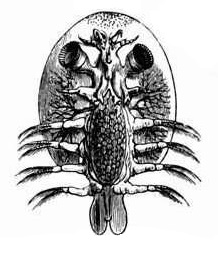
Argulus foliaceus, also known as the common fish louse, is a species of fish lice in the family Argulidae. It is "the most common and widespread native argulid in the Palaearctic" and "one of the most widespread crustacean ectoparasites of freshwater fish in the world", considering its distribution and range of hosts. It can cause the severe disease state argulosis in a wide variety of fish species. It is responsible for epizootic outbreaks that have led to the collapse of aquaculture operations. Fish lice are not related to lice, which are insects.
Pasteuria is a genus of mycelial and endospore-forming, nonmotile gram-positive bacteria that are obligate parasites of some nematodes and crustaceans. The genus of Pasteuria was previously classified within the family Alicyclobacillaceae, but has since been moved to the family Pasteuriaceae.
Miamiensis avidus is a species of unicellular marine eukaryote that is a parasite of many different types of fish. It is one of several organisms known to cause the fish disease scuticociliatosis and is considered an economically significant pathogen of farmed fish. M. avidus is believed to be the cause of a 2017 die-off of fish and sharks in the San Francisco Bay.
Scuticociliatosis is a severe and often fatal parasitic infection of several groups of marine organisms. Species known to be susceptible include a broad range of teleosts, seahorses, sharks, and some crustaceans. The disease can be caused by any one of about 20 distinct species of unicellular eukaryotes known as scuticociliates, which are free-living marine microorganisms that are opportunistic or facultative parasites. Scuticociliatosis has been described in the wild, in captive animals in aquariums, and in aquaculture. It is best studied in fish species that are commonly farmed, in which typical effects of infection include skin ulceration, hemorrhage, and necrosis, with post-mortem examination identifying ciliates in the skin, gills, blood, and internal organs including the brain.
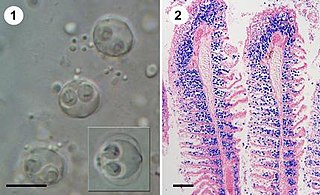
Sphaerospora molnari is a microscopic endoparasite of carp in pond cultures and natural freshwater habitats in Central and Eastern Europe. In natural infections, S. molnari invades the epithelia of gills and surrounding skin regions. It then forms spores in between epithelial cells, causing sphaerosporosis, a pathological condition of the skin and gill tissues. Affected tissues show marked dystrophic changes and necrosis, causing secondary bacterial infections and resulting in osmoregulatory and respiratory failure. Mortalities can reach 100% but little is known about the overall distribution of the parasite species in European carp ponds or its economic impact on carp aquaculture.
Hyalochlorella marina, the only species in the genus Hyalochlorella and also known as Dermocystidium sp., is a marine heterotrophic eukaryote with uncertain phylogenic position.
References
- ↑ "Dermocystidium". www.mycobank.org. Retrieved 2020-05-17.
- ↑ Feist SW, Longshaw M, Hurrell RH, Mander B (April 2004). "Observations of Dermocystidium sp. infections in bullheads, Cottus gobio L., from a river in southern England". J. Fish Dis. 27 (4): 225–31. Bibcode:2004JFDis..27..225F. doi: 10.1111/j.1365-2761.2004.00535.x . PMID 15049890.
- ↑ Ragan MA, Goggin CL, Cawthorn RJ, et al. (October 1996). "A novel clade of protistan parasites near the animal-fungal divergence". Proc. Natl. Acad. Sci. U.S.A. 93 (21): 11907–12. Bibcode:1996PNAS...9311907R. doi: 10.1073/pnas.93.21.11907 . PMC 38157 . PMID 8876236.
- ↑ Sayre, R.M.; Gherna, R.L.; Wergin, W.P. (1983). "Morphological and Taxonomic Reevaluation of Pasteuria ramosa Metchnikoff 1888 and "Bacillus penetrans" Mankau 1975". International Journal of Systematic and Evolutionary Microbiology. 33 (3): 636–649. doi: 10.1099/00207713-33-3-636 .
- ↑ Levine, Norman D. (1978). "Perkinsus gen. n. and Other New Taxa in the Protozoan Phylum Apicomplexa". The Journal of Parasitology. 64 (3): 549. doi:10.2307/3279807. JSTOR 3279807.
- ↑ R. Pascolini; P. Daszak; A. A. Cunningham; et al. (August 2003). "Parasitism by Dermocystidium ranae in a population of Rana esculenta complex in Central Italy and description of Amphibiocystidium n. gen". Diseases of Aquatic Organisms. 56 (1): 65–74. doi: 10.3354/dao056065 . PMID 14524503.
- 1 2 3 4 5 6 7 8 9 10 11 12 Index Fungorum
- ↑ S. Červinka; J. Vítovec; J. Lom; J. Hoška; F. Kubů (November 1974). "Dermocystidiosis–a gill disease of the carp due to Dermocystidium cyprini n.sp". J. Fish Biol. 6 (6): 689–699. Bibcode:1974JFBio...6..689C. doi:10.1111/j.1095-8649.1974.tb05112.x.
- 1 2 Marketta Pekkarinen; Jiří Lom; Colleen A. Murphy; Mark A. Ragan & Iva Dyková (2003). "Phylogenetic Position and Ultrastructure of Two Dermocystidium Species (Ichthyosporea) from the Common Perch (Perca fluviatilis)" (PDF). Acta Protozool. 42: 287–307. Archived from the original (PDF) on 2014-05-18. Retrieved 2011-05-16.
- ↑ E. Elkan (1962). "Dermocystidium Gasterostei n. sp., A Parasite of Gasterosteus Aculeatus L. and Gasterosteus Pungitius L.". Nature. 196 (4858): 958–960. Bibcode:1962Natur.196..958E. doi:10.1038/196958a0. S2CID 4217342.
- 1 2 Qizhong Zhang; Zhijian Wang (2005). "Dermocystidium sp. infection in cultured juvenile southern catfish Silurus meridionalis in China" (PDF). Diseases of Aquatic Organisms. 65 (3): 245–250. doi: 10.3354/dao065245 . PMID 16119893.
- ↑ Zhang, Bo; Gu, Zemao (2022-05-31). "Isolation and identification of Dermocystidium sinipercae sp. n." Journal of Fisheries of China (in Chinese). 46 (5): 741–749. doi:10.11964/jfc.20210312707. ISSN 1000-0615.
- "Dermocystidium". NCBI Taxonomy Browser. 39436.